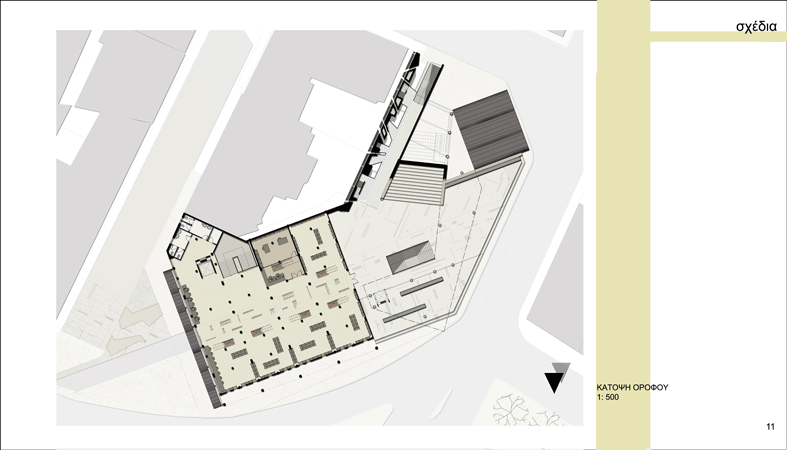

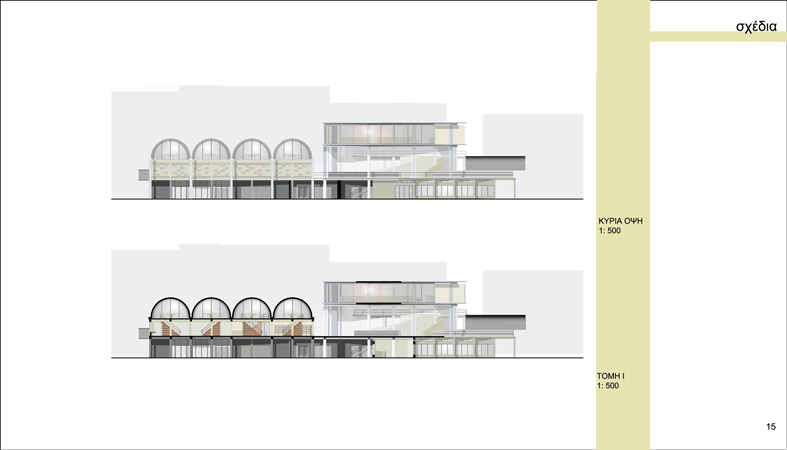

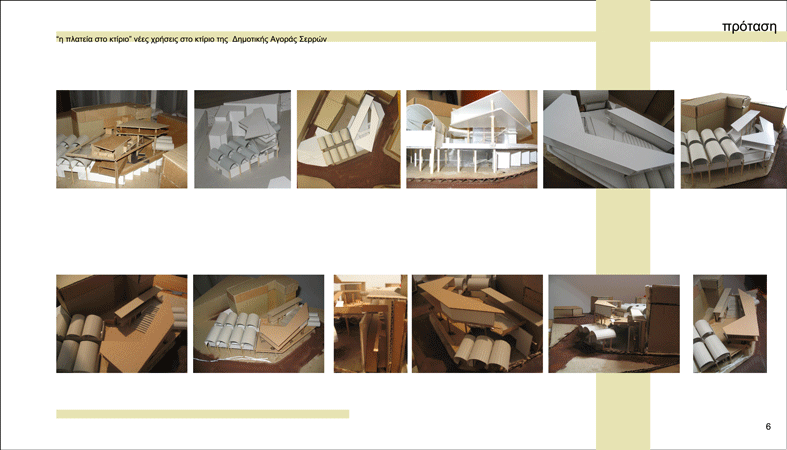

The Popular Market building in Serres is built in the Market Square of town. The building lies on an intersection point of four main roads. Both its concrete arches and arcade justify its domination into the urban iconography.
Built by Moutsopoulos in 1960, it used to accommodate commercial activities. Nowadays, those stores have been converted to storage areas, with a detrimental effect regarding human dealing and commercial life inside the arcade. Either the aging of the building, or the lack of sanitation on behalf of the local Municipality are the reasons why the majority of civilians have lost their appreciation and patience towards the building.
In spite of this, the Market seems to regard itself as a representative of a time when local market and retail commerce had been vital as far as town’s financial welfare is concerned. On the other hand, its mild modern morphology with a repetition of architectural features and functional units, highlight an almost “industrial” sense of building. Last but not least is the concept of Byzantine and muslim typology met in several parts of the building, and is depicted in an interesting sense on the facade.
All those conclusions have led us to put forward an idea of preserving and re- utilizing, in order to ensure that the building remains a perpetual and integral part of regional and square history. A region where traditional stores and wandering dealers do exist, making it swinging between the options of being up- to date or remaining stuck on its recent past.
The Market Square seems unable to fulfill the standards which characterize a public place of walking, resting, accumulating or pausing the urban web.
Its potential activities are totally flattened out by the presence of roads, and they are mainly detected on restricted spaces of pavements and safety islands. The project targets at an intervention into the building, by creating brand new utilities and supporting the concept of enlarging the suppressed free space.
Those new utilities concern both University students and the rest of population, in a duration of a whole day.
Characteristic features of urban formation as crooked lines which compose the facade of the Market and nearby buildings have been the beginning of a synthetic manipulation. The building with its new shape organically participates in the perceptive Square environment, by its oblong and irregular form. Creating a “building into the building”, would succeed to function of a “square into the building”. A project which ensures the sense of current, causing no disturb to the special architectural features of the building.
In the ground floor it is allowed an unforced passage to the stage of the first floor by removing a block of spaces. The entrance of Library (first floor) is in the ground floor as well as supplements of University offices. An internet coffee bar is suggested in the block of stores of a sawal form (north-west part), in an effort to conceptually associate the utility with the industrial character represented by this characteristic form.
In the first floor there is the library which is extended with its reading rooms to the -until now- through empty arches of the upper stage. On the roof of a single- staged part of the Market, there is a scalable surface, functioning both as a ladder and as a shuttle. A high wall with slots brings light into the ground floor and becomes relative with the dominant part of the synthesis, the bar. A space, which lies above the first- floor stage on a light metallic stands and manages to visually restore the building’s relationship with the nearby urban space.
Supervisor: Manolidis Kostas
Reference Number: 8




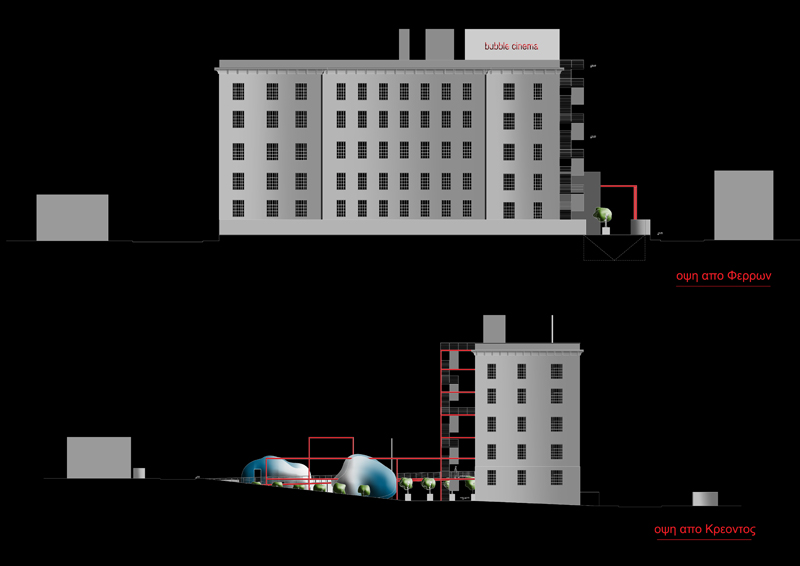

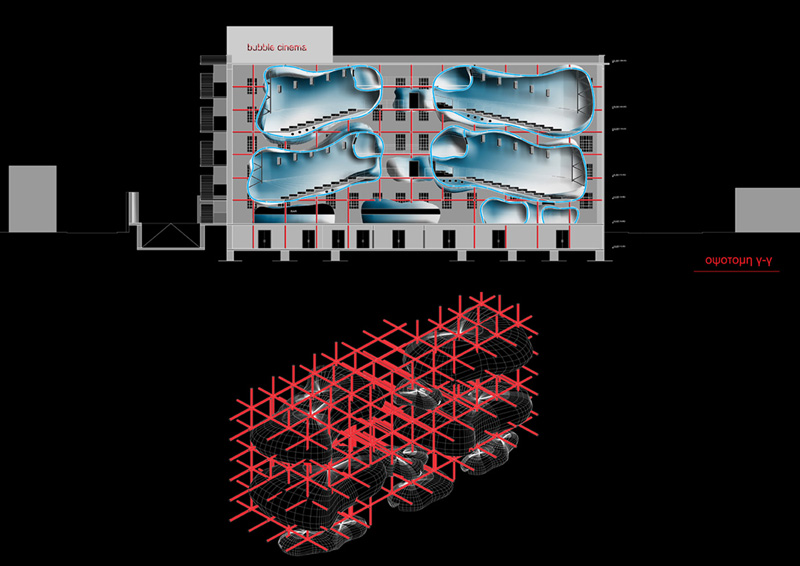

The study includes
1. The creation of metal grid in the interior of building and
extension the grid and outside by this. The grid constitutes a proposal of creation of ideal levels, above in which will be created the suitable courses of movement and service of visitors of cinemas rooms. The metal network is the main element of support of rooms as well as the organism of listed building. The imprinting of building afterwards the deposition presented elements of traces of the main organism of the building. The creation of carcass, continuity of traces is a proposal of connection the listed building with the new intervention
2. the cinemas rooms put in the interior of listed building and in distance by the circumferential walls. The form of rooms and rests of operations, refer in the form and the need of bubbles to hover. The shape of each bubble-room results from the placement of suitable number of such hovering elements in a determined space receiving the better possible form of cover of empty space. The bubbles that are attributed in the study, as spaces of spectacle refer in balloon the cinema drifting and her spectators in this. The manufacture gives the sense of swing new spaces and visitors in this, as well as her tendency of escape from the limits of the circumferential walls. The escape attribute with the extension grid and the balloon in the
building square. The balloon except the functional and utilitarian needs, it proposes a architectural language different from that of listed building, that results from materially and forms of our season. The lack of rectangles elements in the rooms they contribute in the better acoustics of spectators.
Supervisors: Papadopoulos Spiros, Theologidou Cleopatra
Reference Number: 26


The aim of this dissertation is to install accommodation constructions in order to help ‘rediscover’ the landscape through the means of human constructions or local positions that have decayed or whose uses have been disregarded. The above locations are appointed to as ‘territorial trash’.
By structuring cinder blocks and pallets we attempt to design a constructive system that is going to form territorial models thus it will result in becoming an archetype for the production of an outgrowth.
The materials were chosen on the pretext of their almost ‘invisible’ texture since as a rule, they are considered to be the most popular building materials in outdoor constructions to which there is no intention of improvements (agricultural warehouses, folds, fences etc).
The constructional method mentioned above, is going to be referred to under the name of “ICO” following the example of the historical hotels under the commercial name of “XENIA” that constituted the first Greek paradigm of buildings that were ‘stalkers of views’ which indissolubly combined their name along with their image and usage.
Supervisor: Kotionis Zissis
Reference Number: 52


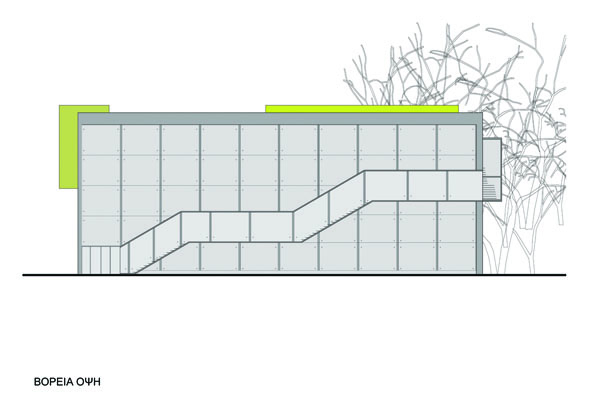

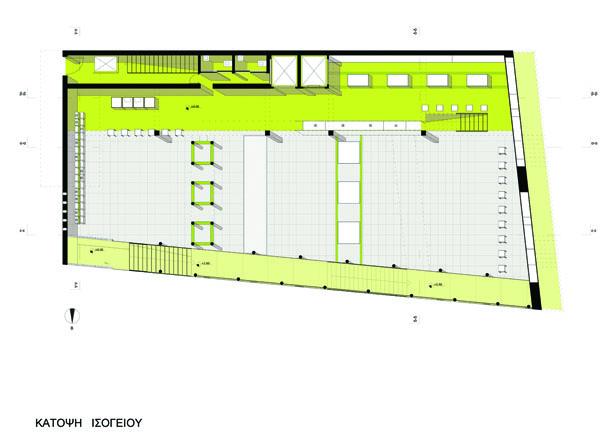



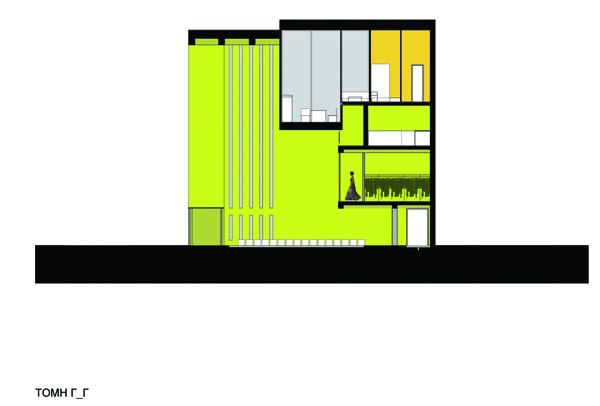

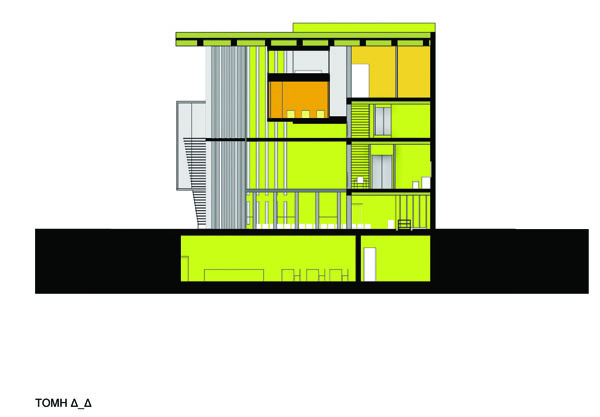

The subject of this diploma project is a store-showroom meant for the Japanese fashion designer Issey Miyake. The store is supposed to be located at the center of Kifissia ( Attiki).
The concept of designing is based on the technique of Miyake’s project, a-poc.
A-poc is based on the possibility of producing endless lengths of new fabric with the help of computer-programmed machines. Patterns can be worked into the textile, and a sophisticated system of links and holes between the two sides of the tube allows the user to cut out seamless clothing from the fabric in different variations. Instead of the strict matrix of wrap and weft that must be sewn in the shape of the human body, a seamless continuum emerges which comes closer to the human form than ever before.
Based on the a-poc, the project aims to bring out the different personality of each user. We tried to design a space that can be compared with a big pipe of raw fabric. Each user will cut the fabric according to his size, as a result of his needs, his aesthetics, his preferences. The users emit their different personalities onto a screen. The screen of a theatre of fashion. A big catwalk, nominal and simultaneously realistic.
The building is divided in three areas. The backside area is constituted of five levels while the remainder space is single with maximum height 12.70m. The building provides spaces for consumption but also for cultural events (art gallery, fashion shows, etc).
Supervisor: Papadopoulos Spiros
Reference Number: 51
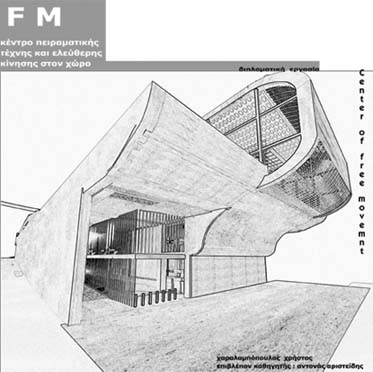

We attempt a small criticism in the Architectural thought as it is organised nowadays. We are not going to analyze architecture as technique, separate from the reasonable thought and the sentiments (therefore easily it can it is portrayed in the space) but as a way of thinking and filling inside a certain space. A poor representation of an idea through a drawing would be the last thing for a sensitive architecture.
A problem that the poor representation of an idea through a drawing haw created is that in each building it should exist a predetermined way which has concrete beginning and determined end. Every building is placed at a main artery or at a crossroad and the arrival or the departure from it, is predetermined. Also, in the interior of buildings the spaces have limited operations and their corridors are spaces of simple circulation without almost any possible function.
The human being is the only being that because of his conscience and his reasonable thought has considered that he could and he can create buildings and landscapes that obey less in the natural environment and more in the human need. We could say that this is the ` utopia of the architectural' thought of the modern person. It has been created the last 200 years because of the advanced technology and the socio-political changes that took place this period.
We will try to give a solution at the problems of architectural thought, but also we will create the beginning of new problem that charmed the human being as an idea since the start of the civilization. The technology of course wasn't so advanced to support the solution of the problem. This is the problem of moving in space without touching the floor. The person with mechanic support will have the possibility of moving in the space, with any combination of the three dimensions, acquiring an unusual perception of space, time and different conditions that prevail in different heights inside the building.
Supervisor: Antonas Aristide
Reference Number: 33
According to the conclusions deriving from the related study within the framework of the investigative subject, the architecture of the mountainous settlements of the Municipality of Istiea is purely folk in character. It is directly connected to the modern history of the area since it reflects the everyday life and the special living conditions, which render it particularly important and worthy of maintenance.
Simultaneously, a study about the current conditions of the area showed a declining course which is primarily due to unemployment. The diploma project is based on the conclusions of the investigative subject. It is divided into three sections. The first one refers to the restoration of the area through the development of alternative forms of tourism. What is recommended is the unification of the settlements through a cultural network. In every settlement particular buildings could be used for cultural purposes aiming at the promotion of the local architecture.
The second section concerns suggestions for the maintenance and the improvement of the cast of features of the settlements at a level of principles. The conservation and the elevation of the traditional buildings is recommended.
This presupposes the maintenance of their style and the atmosphere which characterizes them through interventions which will preserve the appearance, the construction and the constructive materials and through the removal of arbitrary accretions or outbuildings which distort its whole image. Within this framework, different types of accretions which could be added without harming the buildings en terms of aesthetics are explored since these accretions are imperative for the fulfillment of everyday needs.
The third section relates to the study of three buildings, with different function each, in settlements equal in number: a café (public place), the residence of the Turkish agha (the power) and a residence representative of the middle class.
Through the new uses which are recommended what is planned is the maintenance of the buildings in their original form with only few interventions. At the same time their extension to new constructions is proposed. In the designing of the new buildings a different rationale is applied in connection with the existing building. In the case of the café, which is small in size, the accretion follows the logic of the structure of the old building with various alternations so that it is distinguishable.
In the other two cases which refer to bigger buildings, in the designing of new constructions contrast is chosen. In the closed geometrical buildings, the new constructions are analyzed into levels whereas some general principles deriving from the existing buildings are observed.
In all three cases, the designing includes the tidying up of the surrounding area, which aims at the preservation of the harmonious relation between the natural and the built environment.
Supervisor: Theologidou Cleopatra
Reference Number: 14
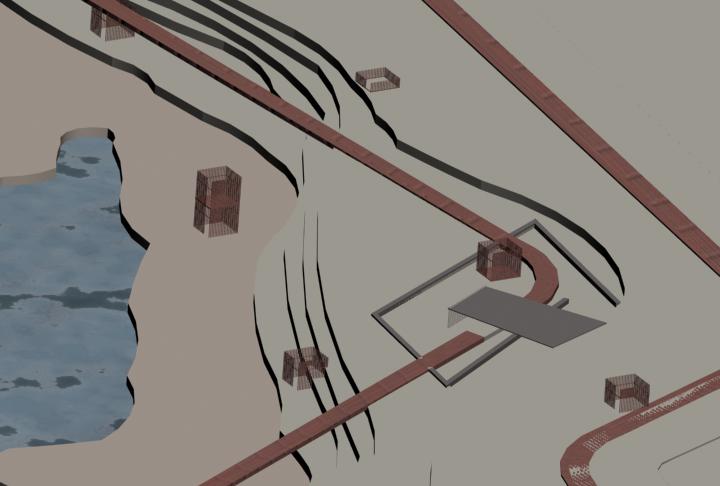

THE PROJECT
The region of this project, named Aliveri, is situated in Volos, next to the river Xirias. This natural factor of the city’s filtration is in danger of debris and transgression.
It consists of a public property of 21.000 m2 and a private one of 32.000 m2 that are under forced expropriation. In this area it has been constructed and soon operated a Handicap Support Center. However, there is an abandoned factory that is not worth of conservation.
The population is consisted of ROM, with characteristic social and financial inequalities. This understated area with low income and poor construction are common traits of the suburbia. The interference in this area is important due to its geographical position, as well as to the inequalities and the complex character of habitation. This area is the only access to the city’s extension whilst the mountain of Pelion in the north and the sea in the south don’t allow the city to be expanded any further.
The lack of any terms concerning the construction of buildings allows for a zone of habitation with the limit of 8.5 m. in height and 0.8% in the coverage of the earth. The aim of the local authorities is to come to a house model and the project of a linear park along the river, which it will be protected and reformed through an entertainment function.
In the project’s area there are different groups of habitants of various profile, culture and social status, like ROM. The people that live there from that time forth will be a combination of these groups.
The project’s area is a gap in the urban space, which must be connected to the other urban areas in a way that it manages to combine functions and social groups. In the meantime, it will improve and protect the environment having the control of the car’s traffic.
Supervisor: Triantafillidis Giorgos
Reference Number: 12


The subject of present diploma thesis is a building group of hospitality in the city of Veria. The parcel of application is found in the fringes of centre of city, in the banks of river Trjpotamos. The wider region has been characterized as a region of particular natural beauty. Simultaneously, in small distance of the study area, is the traditional settlement of Barbouta, which at the previous century constituted the Jewish district. At the same time, refugees from the coasts of Turkey, Mikra Asia, were positioned, in 1922, in this area.
The existence of congress centre of Pan-Hellenic scope in combination with the Balkan centre of Architecture, already found in the Barbouta, creates the need for the manufacture of a building that might cover the existing void regarding to the hospitality of research teams, the conduct of congresses and remaining educational programs. Thus, in the building program, beyond the staying areas, are also predicted workstations, a exhibition area and presentation areas. Because the uses that are included to the building group, acquires a public character, it is addressed not only in research teams but also in the residents of city.
The research was focused mainly in the integration of building group of hospitality, in a environment where the natural element has one very intense presence while at the same time it constitutes a part of urban architecture.
Supervisor: Manolidis Kostas
Reference Number: 43

